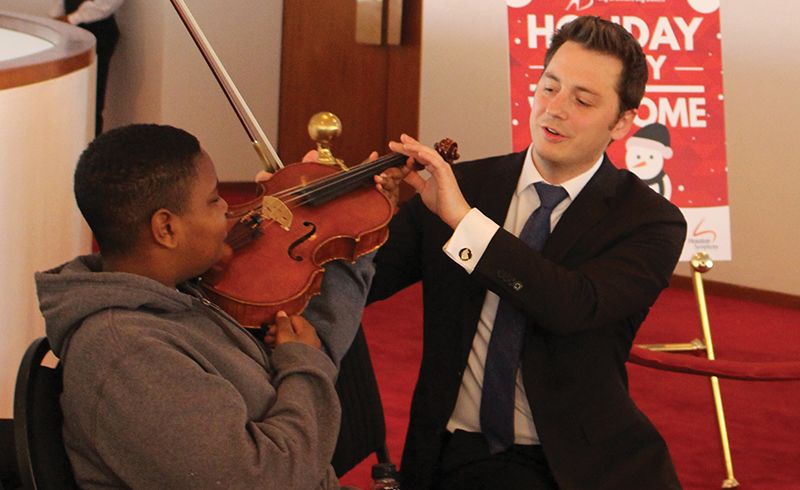
September 25, 2018
Wolfgang’s Dark Side: Mozart’s Symphony No. 40 in G minor
On October 18, 20 and 21, legendary violinist Itzhak Perlman returns to the Houston Symphony for our Perlman Plays and Conducts program. In addition to performing Bach’s Violin Concerto in A minor, Perlman will also conduct Mozart’s powerful Symphony No. 40 in G minor. Learn more about this unsurpassed masterpiece in this post.

Mozart composed his magnificent final three symphonies during the summer of 1788. This was the beginning of a difficult period for Mozart; after his opera Don Giovanni received a lukewarm reception in Vienna in the spring, a perfect storm of changing tastes, impending war and economic malaise conspired to create financial difficulties for the composer. The three symphonies were likely composed for a concert series in August in one of Vienna’s casinos (which were closer to modern day country clubs than gambling dens), although it is uncertain whether these concerts ultimately took place. It seems likely that this symphony at least was programmed for another occasion, because Mozart later added clarinets to its orchestration (this version will be performed at this concert). Nevertheless, it cannot be known for certain whether Mozart ever heard it performed during the three years he had left to live.
In contrast with the joyful brilliance of the other two symphonies Mozart composed that summer, this one has a darker mood. The key of G minor seems to have held a special significance for Mozart, as he reserved it for some of his most emotionally intense works. The symphony begins with a rustling accompaniment in the violas, above which the violins play a breathless sighing figure that unfolds in a melancholy melody:
https://www.youtube.com/watch?v=xBlFGDbPxsY
After a threatening interruption, the melody leads to a stronger passage that transitions to a new, contrasting theme. Preceded by a brief pause (as if the orchestra were taking a breath), this new melody is based on descending chromatic scales and has a brighter character. Passed back and forth between the strings and woodwinds, the theme builds to an exuberant passage based on the opening melody, which now takes on a completely different character.
These two main themes are then repeated, leading to an intense developmental section obsessively focused on the opening theme. The theme reappears as the music slides into a distant key. With each phrase it drifts farther and farther away from harmonic stability, until the orchestra erupts in a violent, contrapuntal passage in which the theme is passed between the lowest and highest instruments of the orchestra. As the development progresses, the theme becomes increasingly fragmented, as Mozart focuses on smaller and smaller pieces of it, especially the characteristic “sighing” figure. At last, the music returns to the home key of G minor for the reprise of the two main themes. This time, however, the bridge passage to the second theme seems to take a wrong turn, and the once bright and exuberant second theme now becomes dark and mournful, transposed into the main key of G minor.

The nineteenth-century Russian commentator Alexandre Oulibicheff described the slower second movement as a “dream escaped through the ivory gates of Elysium.” Indeed, the movement offers respite from the intensity of the previous one with a gentle pulsing in the strings, although this tranquil surface is belied by a chromaticism that for Oulibicheff “touches on the supernatural.” In addition to the pulsing figure, Mozart soon introduces a second idea in the form of pairs of flitting sixteenth notes that float like falling leaves through the score. These two figures transition to a second theme of simple falling figures, perhaps imitating the natural sounds of a forest. After an expressive harmonic digression, the two themes are repeated. A searching developmental passage follows, leading to a reprise of the main themes. The development and reprise are also repeated, creating a symmetrical structure with the first half of the movement (note that many conductors choose to omit one or both repeats). This enchanting, yet mysterious music seems to look forward to the fantastic sound world Mozart would create in his opera The Magic Flute.
Returning to the dark main key of G minor, the imperious minuet that follows begins with a striking hemiola: the melody is written as if the meter is 2/4, while the accompaniment is in the 3/4 meter one would expect from a minuet. This creates a powerful tension that propels the music forward, and the texture of the minuet becomes more complex and contrapuntal as it progresses. In contrast, the middle section is in the key of G major, and is full of sweetness and simplicity. It features lovely, transparent parts for the horns and woodwinds before the music returns to the opening G minor minuet.
The finale returns to the tempestuous character of the opening movement and follows a similar formal pattern. It begins with a theme whose wide range and wild contrasts of soft and loud are balanced by a symmetrical, regular phrase structure. This uneasy balance gives way to the furious runs in the violins that transition to a brighter second theme, which occurs after a brief pause as in the first movement. After a repeat of these themes, a more turbulent developmental section begins with a strange, harmonically disorienting version of the main theme that uses every note of the chromatic scale except G, the main tonal center of the entire symphony. After an ingenious series of developments based on the opening theme, the main themes are reprised. As in the first movement, the once bright, major-key second theme returns in a gloomy G minor guise. As in the second movement, the second half of the movement is also repeated, bringing the symphony to its fiery conclusion. —Calvin Dotsey
Don’t miss Mozart’s Symphony No. 40 in G minor on October 18, 20 & 21, 2018! Get tickets and more information at houstonsymphony.org.






